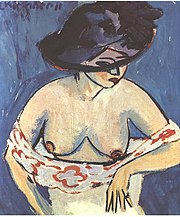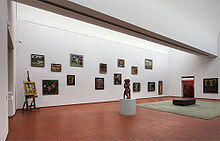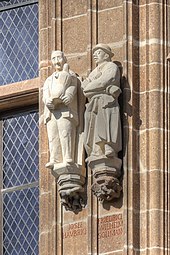Josef Haubrich

Josef Haubrich (born June 15, 1889 in Cologne , † September 4, 1961 in Bad Münstereifel ) was a Cologne lawyer and art collector who was able to preserve his important collection of expressionist art over the years of National Socialism and donated it to his hometown in 1946. After Haubrich, the area of cultural institutions near Neumarkt was named Josef-Haubrich-Hof and the exhibition building there from 1967 to 2001 was named Josef-Haubrich-Kunsthalle .
Life
Childhood, youth and education
Josef Haubrich was born in 1889 as the first child of Nikolaus Wilhelm Haubrich and Maria Christine Hubertine Wilhelmine Haubrich, b. Ritzefeld born. He grew up with his siblings Leo and Paula in a wealthy middle-class family and through his father, who was interested in art, had contact with the then established art as a child and adolescent, for example through study trips, but also through the newly created municipal museums in Cologne such as the Wallraf-Richartz- Museum , the Museum of Applied Arts , the Schnütgen Museum and the Rautenstrauch-Joest Museum .
After attending secondary school and grammar school on Kreuzgasse , Haubrich passed his Abitur in 1907 and moved to Munich for the summer semester of the same year to take up law studies; the following winter, however, he moved to Berlin. In both cities he sought to connect with the local art scene, but did not lose sight of his studies. He spent two semesters back home at the University of Bonn , so that in 1910 he was able to take his legal traineeship at the Cologne Higher Regional Court . In 1913 he submitted his dissertation under the title “The discounting of book claims” to the University of Rostock .
Contact with the art scene in the pre-war period
In the years before the First World War there was movement in the Cologne art world; the Wallraf-Richartz-Museum bought a first painting by van Gogh and a collection of pictures by Wilhelm Leibl ; In addition, in 1912 the Sonderbund exhibition, which pioneered modern art, took place with works by van Gogh, Cézanne , Picasso and many others. For the young Haubrich, the encounter with over 600 works of contemporary art was likely to have shaped his enthusiasm for new developments in art. In addition, there was the Cologne Werkbund exhibition in 1914 with further impulses.
After his legal clerkship , Haubrich passed his assessor exam in Berlin in 1915 ; In 1916 he stayed in Berlin for a further few weeks to undergo his draft, during which he was permanently disabled due to a heart defect. An encounter with Herwarth Walden and the works of Franz Marc at this time is considered by the biographer Peter Fuchs to be the hour of birth of Haubrich's passion for expressionism . His first self-acquired sculpture was a sculpture by Wilhelm Lehmbruck , who was still considered too avant-garde by many .
Haubrich opened a law firm with his friend Heinrich Bodenheim (1884–1949), which flourished very quickly, and in 1916 married Johanna Kux, the daughter of the managing director of the Kalk chemical factory . Their children, Karl-Klaus (1917–1945) and Ruth Luise (* 1919), emerged from the marriage.
Building up the collection in the Weimar Republic
In the years after the end of the war, Haubrich laid the foundation for his extensive collection of expressionist art. While a watercolor by Otto Dix was still available for half a US dollar during the period of inflation, in 1923/1924 he paid around 10,000 gold marks for two works by James Ensor , the equivalent of several high-quality properties at the time. Haubrich became deputy chairman of the Kölnischer Kunstverein and wrote under the pseudonym Dr. Ludwig Josef art reviews in the social democratic Rheinische Zeitung . In doing so, he did not skimp on criticism of the city's cultural administration, which he accused of neglecting the purchase of modern art.
After his wife died in 1922 and Haubrich stayed behind with his two children, he married Amalie Antonie Timmermanns in 1923; The marriage was soon divorced, however, and in 1929 he entered into a third marriage with the Jewish gynecologist Alice Gottschalk .
Preservation of “degenerate art” 1933–1945
After the National Socialists came to power, Haubrich's collection fell into the “ Degenerate Art ” category , and Haubrich was excluded from the Kölnischer Kunstverein due to his wife's “race”, which is said to have been implemented more pro forma. He had to part with his lawyers for the same reasons; the office was split up and Haubrich worked from then on in his private home.
Haubrich continued his acquisitions and thus saved a number of the works of art that were not wanted in museums. While 47 exhibits - almost the entire post-impressionist collection - were removed from the Wallraf-Richartz-Museum after 1937, Haubrich expanded his collection by 45 pieces between 1933 and 1945. After the Gestapo searches, he moved a large part of his collection out of his house; some he stored in the depot of the Wallraf-Richartz-Museum, other pieces outside Cologne as far as London.
After the outbreak of war, Haubrich concentrated on his legal work and otherwise withdrew into private life. The increasing Gestapo pressure, especially on his wife, drove her to suicide in early 1944 . Haubrich married the widowed Paula Anna Berta Wegelin, née Sieb, in November 1944. In January 1945 he was drafted into the Landsturm , but not put into service for health reasons. Soon afterwards he learned that his son Karl-Klaus had perished in the Königsberg pocket. As for the fighting in Hürtgenwald the castle Untermaubach came under fire of the US Army, he managed in a night raid stored there pieces of the Cologne Kunstverein and own works of art back to Cologne, has been exposed to still air raids.
Engagement in post-war Cologne

When Cologne was largely in ruins at the end of the war in 1945, the Haubrich Collection had survived the war almost completely and undamaged. The invading Americans put Haubrich's house with the collection under special protection and gave him a job as a lawyer in the military justice system. In June 1945, however, the British occupying power took over Cologne and subordinated the newly constituted city council - to which Haubrich was a member until his death in 1946 - completely to the commander of the military government. In addition, Haubrich's private house was confiscated.
In this situation Haubrich decided to donate his entire collection to the city of Cologne. On May 2, 1946, the city council in the presence of Haubrich accepted the donation. It contained hundreds of paintings, watercolors, drawings and sculptures, including works by Hans Arp , Ernst Barlach , Max Beckmann , Marc Chagall , Lovis Corinth , Otto Dix , Max Ernst , George Grosz , Ernst Ludwig Kirchner , Oskar Kokoschka , Max Liebermann , Paula Modersohn-Becker , Emil Nolde , Karl Schmidt-Rottluff , Maurice Utrillo and many others. The material value of the collection was around 7 million Reichsmarks before the currency reform ; soon after the reform, the value rose sharply. The collector attached few conditions to the donation, but continued to influence further acquisitions and the development of the holdings for years. In accordance with the donation agreement, he supported the expansion and “mixing” with works of other origins.

As chairman of the municipal culture committee, Haubrich contributed to the new building of the Wallraf-Richartz-Museum, which was realized from 1953 to 1957 according to plans by Rudolf Schwarz . Until the new museum was completed, the collection - "the most important collection of modern art in Germany" was shown at exhibitions in 30 European cities.
Haubrich continued to be involved in numerous organizations and committees, including the board of trustees of the Kölner Werkschulen , the federal board of the German Werkbund , the Rhineland Regional Assembly and as a juror at various art prizes. In 1951 Wilhelm Riphahn had a new house built for him in Cologne-Müngersdorf , in whose so-called "Tuskulum", a circular building, his library and - on loan - individual items from his collection were housed. After his fourth wife died in 1959, he married the Cologne actress Lucy Millowitsch in Venezuela in 1960 .
Haubrich died unexpectedly of a stroke in September 1961 while on vacation in Bad Münstereifel . He was buried in Cologne's Westfriedhof , but in 1987 he was reburied in the Melaten cemetery .
Aftermath
While Haubrich was still alive, the collection was housed in the newly constructed building of the Wallraf-Richartz-Museum, now the Museum of Applied Arts. The extensive Ludwig collection was added here in 1976. With the new building of the Museum Ludwig , which initially also housed the Wallraf-Richartz-Museum, the Haubrich Collection found its place in the permanent exhibition on the first floor of the exhibition building.
Shortly after Haubrich's death - from October 8 to November 12, 1961 - there was an exhibition in the Wallraf-Richartz Museum on the subject of “Josef Haubrich in a Portrait”. In March 1964, the main committee of the city council decided to name the space in front of the new art gallery under construction in honor of the founder Josef-Haubrich-Hof . The inauguration of the art gallery with Haubrich's exhibits took place here on April 15, 1967 on the site of the former community hospital. On June 15, 1979, on the occasion of Josef Haubrich's 90th birthday, it was given the name Josef-Haubrich-Kunsthalle , which was demolished in October 2002 to make way for a new museum complex. The foundation stone was laid on June 14, 2005, and on October 22, 2010 the new cultural center, the Rautenstrauch-Joest-Museum für Völkerkunde, an extension of the existing Museum Schnütgen , part of the adult education center already located there and the museum's educational service opened City of Cologne has recorded. The 88.5 meter long building has a 21 meter high entrance with a total height of 24 meters and has an exhibition area of 4,939 m².
Awards
- 1954 Grand Cross of Merit of the Federal Republic of Germany
- 1961 Commander's Cross of the Order of Merit of the Republic of Italy
- 1959 Belgian Leopold Order
- 1959 Honorary doctorate from the Philosophical Faculty of the University of Cologne
- His figure, donated by the Ludwig couple , has been decorating the town hall tower since 1991
- 2016, posthumously, Jabach Medal of the City of Cologne on the 70th anniversary of its donation
literature
- Peter Fuchs (Ed.): Josef Haubrich. Collectors and donors. Art of the XX. Century in Cologne. Greven, Cologne 1959
- Peter Fuchs: Josef Haubrich. Collectors and donors of modern art. News Office of the City of Cologne, 1979 (partly word for word with Fuchs edition from 1959)
- Otto H. Förster: A Lions friend as an art collector and museum donor - L Josef Haubrich in memory . In: Lions No. 12, December 1962
- Horst Keller: Haubrich, Josef. In: New German Biography (NDB). Volume 8, Duncker & Humblot, Berlin 1969, ISBN 3-428-00189-3 , pp. 73 f. ( Digitized version ).
- Birgit Kilp: Josef Haubrich. A lawyer for the arts , Wienand, Cologne 2016, ISBN 978-3-86832-223-1 .
- Hans Schmitt-Rost : Josef Haubrich A friend. Published by the Friends of the Wallraf-Richartz-Museum Cologne, Cologne 1963
- Josef Haubrich: Dealing with modern painters. Culture that not only feeds on the past . In: * Die Zeit , No. 37/2008, from Haubrich's memory sheets
Web links
- Anke von Heyl: Josef Haubrich - a life with art on kulturtussi.de
- WDR 3 (Westdeutscher Rundfunk) resonances from May 30, 2016: 70 years of the Josef Haubrich Foundation - the visionary collector of modernism as the founder of Cologne, the city of art
References and comments
- ↑ Various publications mention September 5th as the date of death, mostly quoted from biographer Peter Fuchs (1979), such as the Cologne Personal Lexicon, the NDB (see section on literature) and others. a .; the tombstone on Melaten and the card index of the cemetery administration at the Westfriedhof indicate September 4, 1961, also in the estate of Ernst Schwering of the historical archive : archive.nrw.de : "Letter of condolence [...] on the death of Josef Haubrich (Sept. 4 ) "; also Werner Schäfke in Das neue Köln 1945–1995, p. 167
- ^ Werner Schäfke : Das neue Köln 1945–1995 , exhibition catalog, 1995, ISBN 3-927396-62-1 , p. 269
- ↑ Telephone information for the Cologne cemetery administration, Mrs. Aust, relocation of Josef and Alice Haubrich on June 3, 1987
- ↑ Werner Schäfke , Das neue Köln 1945–1995, exhibition catalog, 1995, ISBN 3-927396-62-1 , various sources
- ↑ Kölner Loch vanished: Schneider and Sendelbach cultural center finished
- ↑ To all data: Haubrich at portal rheinische-geschichte.lvr.de
- ↑ Note at kunstmarkt.com
| personal data | |
|---|---|
| SURNAME | Haubrich, Josef |
| ALTERNATIVE NAMES | Josef Ludwig (pseudonym) |
| BRIEF DESCRIPTION | Cologne art collector and patron |
| DATE OF BIRTH | June 15, 1889 |
| PLACE OF BIRTH | Cologne |
| DATE OF DEATH | 4th September 1961 |
| Place of death | Bad Münstereifel |


